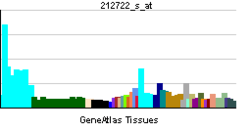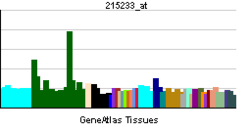JMJD6
Bifunctional arginine demethylase and lysyl-hydroxylase JMJD6 is an enzyme that in humans is encoded by the JMJD6 gene.[1][2]
This gene encodes a nuclear protein with a JmjC domain. JmjC domain-containing proteins are predicted to function as protein hydroxylases or histone demethylases. This protein was first identified as a putative phosphatidylserine receptor involved in phagocytosis of apoptotic cells; however, subsequent studies have suggested that the protein may cross-react with a monoclonal antibody that recognizes the phosphatidylserine receptor and does not directly function in the clearance of apoptotic cells. Multiple transcript variants encoding different isoforms have been found for this gene.[2]
References
- ↑ Vandivier RW, Fadok VA, Hoffmann PR, Bratton DL, Penvari C, Brown KK, Brain JD, Accurso FJ, Henson PM (Mar 2002). "Elastase-mediated phosphatidylserine receptor cleavage impairs apoptotic cell clearance in cystic fibrosis and bronchiectasis". J Clin Invest 109 (5): 661–70. doi:10.1172/JCI13572. PMC 150889. PMID 11877474.
- ↑ 2.0 2.1 "Entrez Gene: JMJD6 jumonji domain containing 6".
Further reading
- Webby CJ, Wolf A, Gromak N, Dreger M, Kramer H, Kessler B, Nielsen ML, Schmitz C, Butler DS, Yates JR 3rd, Delahunty CM, Hahn P, Lengeling A, Mann M, Proudfoot NJ, Schofield CJ, Böttger A (2009). "Jmjd6 catalyses lysyl-hydroxylation of U2AF65, a protein associated with RNA splicing". Science 325 (5936): 90–3. doi:10.1126/science.1175865. PMID 19574390.
- Zakharova L, Dadsetan S, Fomina AF (2009). "Endogenous Jmjd6 gene product is expressed at the cell surface and regulates phagocytosis in immature monocyte-like activated THP-1 cells". J. Cell. Physiol. 221 (1): 84–91. doi:10.1002/jcp.21829. PMID 19492415.
- Hahn P, Böse J, Edler S, Lengeling A (2008). "Genomic structure and expression of Jmjd6 and evolutionary analysis in the context of related JmjC domain containing proteins". BMC Genomics 9: 293. doi:10.1186/1471-2164-9-293. PMC 2453528. PMID 18564434.
- Chang B, Chen Y, Zhao Y, Bruick RK (2007). "JMJD6 is a histone arginine demethylase". Science 318 (5849): 444–7. doi:10.1126/science.1145801. PMID 17947579.
- Klose RJ, Kallin EM, Zhang Y (2006). "JmjC-domain-containing proteins and histone demethylation". Nat. Rev. Genet. 7 (9): 715–27. doi:10.1038/nrg1945. PMID 16983801.
- Williamson P, Schlegel RA (2005). "Hide and seek: the secret identity of the phosphatidylserine receptor". J. Biol. 3 (4): 14. doi:10.1186/jbiol14. PMC 549716. PMID 15453906.
- Böse J, Gruber AD, Helming L et al. (2005). "The phosphatidylserine receptor has essential functions during embryogenesis but not in apoptotic cell removal". J. Biol. 3 (4): 15. doi:10.1186/jbiol10. PMC 549712. PMID 15345036.
- Nagase T, Ishikawa K, Miyajima N et al. (1998). "Prediction of the coding sequences of unidentified human genes. IX. The complete sequences of 100 new cDNA clones from brain which can code for large proteins in vitro". DNA Res. 5 (1): 31–9. doi:10.1093/dnares/5.1.31. PMID 9628581.
- Fadok VA, Bratton DL, Rose DM et al. (2000). "A receptor for phosphatidylserine-specific clearance of apoptotic cells". Nature 405 (6782): 85–90. doi:10.1038/35011084. PMID 10811223.
- Strausberg RL, Feingold EA, Grouse LH et al. (2003). "Generation and initial analysis of more than 15,000 full-length human and mouse cDNA sequences". Proc. Natl. Acad. Sci. U.S.A. 99 (26): 16899–903. doi:10.1073/pnas.242603899. PMC 139241. PMID 12477932.
- Ajmone-Cat MA, De Simone R, Nicolini A, Minghetti L (2003). "Effects of phosphatidylserine on p38 mitogen activated protein kinase, cyclic AMP responding element binding protein and nuclear factor-kappaB activation in resting and activated microglial cells". J. Neurochem. 84 (2): 413–6. doi:10.1046/j.1471-4159.2003.01562.x. PMID 12559004.
- Chan A, Seguin R, Magnus T et al. (2003). "Phagocytosis of apoptotic inflammatory cells by microglia and its therapeutic implications: termination of CNS autoimmune inflammation and modulation by interferon-beta". Glia 43 (3): 231–42. doi:10.1002/glia.10258. PMID 12898702.
- Wang X, Wu YC, Fadok VA et al. (2003). "Cell corpse engulfment mediated by C. elegans phosphatidylserine receptor through CED-5 and CED-12". Science 302 (5650): 1563–6. doi:10.1126/science.1087641. PMID 14645848.
- Ota T, Suzuki Y, Nishikawa T et al. (2004). "Complete sequencing and characterization of 21,243 full-length human cDNAs". Nat. Genet. 36 (1): 40–5. doi:10.1038/ng1285. PMID 14702039.
- Cui P, Qin B, Liu N et al. (2004). "Nuclear localization of the phosphatidylserine receptor protein via multiple nuclear localization signals". Exp. Cell Res. 293 (1): 154–63. doi:10.1016/j.yexcr.2003.09.023. PMID 14729065.
- Cao WM, Murao K, Imachi H et al. (2005). "Phosphatidylserine receptor cooperates with high-density lipoprotein receptor in recognition of apoptotic cells by thymic nurse cells". J. Mol. Endocrinol. 32 (2): 497–505. doi:10.1677/jme.0.0320497. PMID 15072554.
- Cikala M, Alexandrova O, David CN et al. (2004). "The phosphatidylserine receptor from Hydra is a nuclear protein with potential Fe(II) dependent oxygenase activity". BMC Cell Biol. 5: 26. doi:10.1186/1471-2121-5-26. PMC 442123. PMID 15193161.
- Hong JR, Lin GH, Lin CJ et al. (2004). "Phosphatidylserine receptor is required for the engulfment of dead apoptotic cells and for normal embryonic development in zebrafish". Development 131 (21): 5417–27. doi:10.1242/dev.01409. PMID 15469976.
- Gerhard DS, Wagner L, Feingold EA et al. (2004). "The status, quality, and expansion of the NIH full-length cDNA project: the Mammalian Gene Collection (MGC)". Genome Res. 14 (10B): 2121–7. doi:10.1101/gr.2596504. PMC 528928. PMID 15489334.
- Köninger J, Balaz P, Wagner M et al. (2005). "Phosphatidylserine receptor in chronic pancreatitis: evidence for a macrophage independent role". Ann. Surg. 241 (1): 144–51. PMC 1356857. PMID 15622002.


